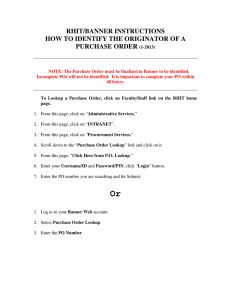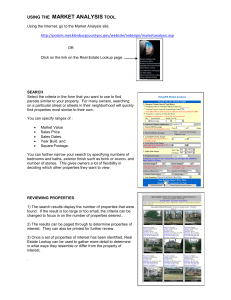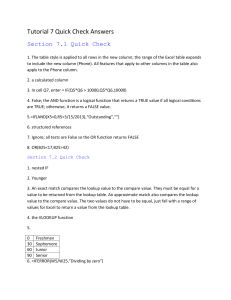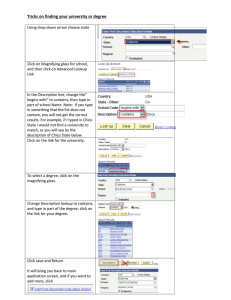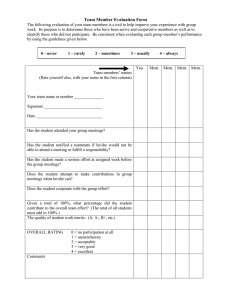Bit-Reverse and Digit- Reverse
advertisement
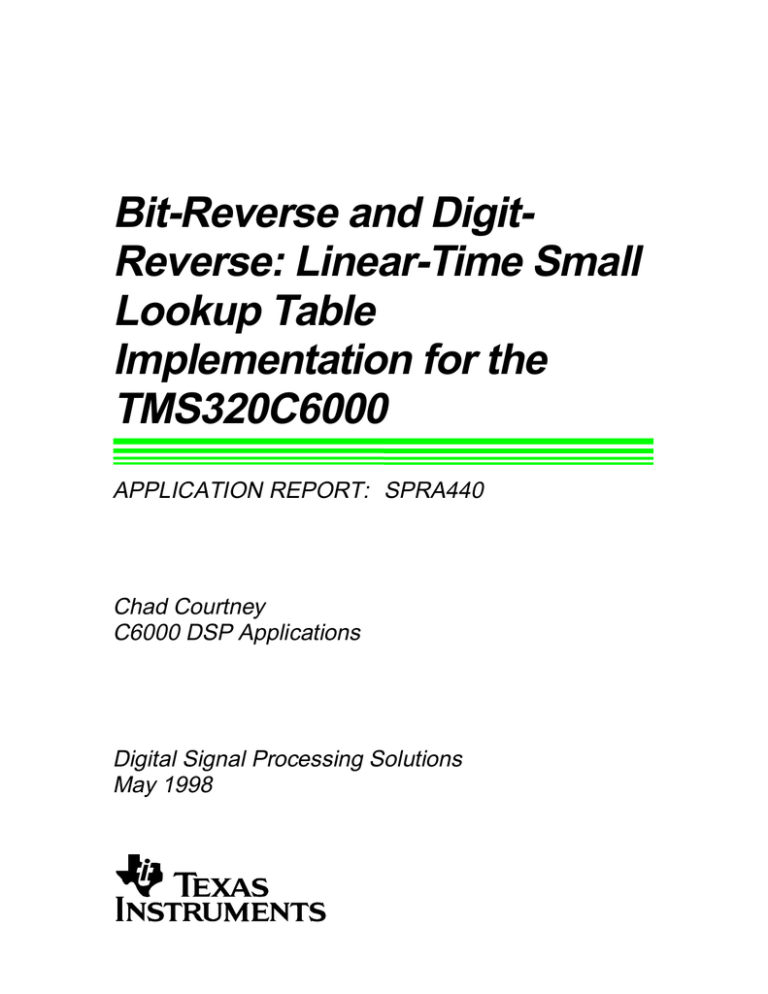
Bit-Reverse and DigitReverse: Linear-Time Small
Lookup Table
Implementation for the
TMS320C6000
APPLICATION REPORT: SPRA440
Chad Courtney
C6000 DSP Applications
Digital Signal Processing Solutions
May 1998
IMPORTANT NOTICE
Texas Instruments (TI) reserves the right to make changes to its products or to discontinue any
semiconductor product or service without notice, and advises its customers to obtain the latest version of
relevant information to verify, before placing orders, that the information being relied on is current.
TI warrants performance of its semiconductor products and related software to the specifications applicable
at the time of sale in accordance with TI’s standard warranty. Testing and other quality control techniques
are utilized to the extent TI deems necessary to support this warranty. Specific testing of all parameters of
each device is not necessarily performed, except those mandated by government requirements.
Certain application using semiconductor products may involve potential risks of death, personal injury, or
severe property or environmental damage (“Critical Applications”).
TI SEMICONDUCTOR PRODUCTS ARE NOT DESIGNED, INTENDED, AUTHORIZED, OR WARRANTED
TO BE SUITABLE FOR USE IN LIFE-SUPPORT APPLICATIONS, DEVICES OR SYSTEMS OR OTHER
CRITICAL APPLICATIONS.
Inclusion of TI products in such applications is understood to be fully at the risk of the customer. Use of TI
products in such applications requires the written approval of an appropriate TI officer. Questions concerning
potential risk applications should be directed to TI through a local SC sales office.
In order to minimize risks associated with the customer’s applications, adequate design and operating
safeguards should be provided by the customer to minimize inherent or procedural hazards.
TI assumes no liability for applications assistance, customer product design, software performance, or
infringement of patents or services described herein. Nor does TI warrant or represent that any license,
either express or implied, is granted under any patent right, copyright, mask work right, or other intellectual
property right of TI covering or relating to any combination, machine, or process in which such
semiconductor products or services might be or are used.
Copyright © 1998, Texas Instruments Incorporated
TRADEMARKS
TI is a trademark of Texas Instruments Incorporated.
Other brands and names are the property of their respective owners.
CONTACT INFORMATION
US TMS320 HOTLINE
(281) 274-2320
US TMS320 FAX
(281) 274-2324
US TMS320 BBS
(281) 274-2323
US TMS320 email
dsph@ti.com
Contents
Product Support............................................................................................................ 8
World Wide Web ....................................................................................................... 8
Email......................................................................................................................... 8
Introduction................................................................................................................... 9
Linear Time Small Lookup Table Bit-Reverse Routine: ........................................... 15
Linear Time Small Lookup Table Routine: ................................................................ 18
IMPROVED Bit/Digit-Reverse Routines: .................................................................... 20
Appendix A. Program 1 ............................................................................................. 22
Appendix B. Program 2 ............................................................................................. 23
Appendix C. Program 3 ............................................................................................. 24
Appendix D. Program 4 ............................................................................................. 25
Appendix E. Program 5.............................................................................................. 27
Figures
Figure 1.
Figure 2.
Figure 3.
Figure 4.
Figure 5.
Figure 6.
In-Place Discrete Transform Using Decimation-in-Frequency ........................... 9
Order Sorting Tree .......................................................................................... 11
2-Digit Digit Order Sorting Tree ....................................................................... 13
Normal and Bit-Reverse Order Sorting............................................................ 15
8-point Bit-Reverse Order Sort ........................................................................ 17
Two-Digit Order Sorting Tree with Small Lookup Table................................... 18
Tables
Table 1.
Table 2.
Table 3.
Memory vs. Output Hex and Bit Output ........................................................... 10
Combinations of the Middle Bits Represented by X ......................................... 20
2-Bit Digit Reverse .......................................................................................... 21
Bit-Reverse and Digit-Reverse:
Linear-Time Small Lookup Table
Implementation for the TMS320C6000
Abstract
This application report describes a fast method of implementing
bit-reverse and digit-reverse routines using a small lookup table.
The author provides background on the bit-reverse and digitreverse routines including theory behind the implementation and
how the linear-time small lookup table method is implemented.
Implementing a Linear-Time Small Lookup Table for the TMS320C6000
7
SPRA440
Product Support
World Wide Web
Our World Wide Web site at www.ti.com contains the most up to
date product information, revisions, and additions. Users
registering with TI&ME can build custom information pages and
receive new product updates automatically via email.
Email
For technical issues or clarification on switching products, please
send a detailed email to dsph@ti.com. Questions receive prompt
attention and are usually answered within one business day.
8
Implementing a Linear-Time Small Lookup Table for the TMS320CC6000
SPRA440
Introduction
Bit-reverse and digit-reverse routines are routines in which the
data is reordered based on its index value from 0 to N-1, where N
is the number of points to be bit/digit-reversed.
Discrete transforms are the main users of bit-reverse and digitreverse routines. Discrete transforms take discrete inputs in one
domain and convert them to discrete inputs in another. For
example, a fast fourier transform (FFT) takes a discrete time
domain input and transforms it into the discrete frequency domain
output (i.e. x(t) -> X(jwt).)
Many discrete transforms (FFT, DCT, IDCT, DST, etc.) are
executed in place using the same memory locations for both the
input and output. This reduces both data size and algorithmic
complexity. Bit/digit-reversing routines are needed to take full
advantage of in-place execution. For example, if the in-place
routine uses decimation-in-frequency (DIF) decomposition, the
input is in normal order but the output is in bit/digit-reverse order,
as shown in Figure 1.
Figure 1. In-Place Discrete Transform Using Decimation-in-Frequency
x[0]
mem[0]
mem[0]
X[0]
x[1]
x[2]
x[3]
mem[1]
mem[1]
mem[2]
mem[2]
X[4]
X[2]
x[4]
x[5]
x[6]
x[7]
mem[4]
mem[3]
In-Place
Discrete
Transform
mem[3]
mem[4]
X[6]
X[1]
mem[5]
mem[5]
mem[6]
mem[6]
X[5]
X[3]
mem[7]
mem[7]
X[7]
To view the resulting output in normal order, the results must be
bit-reversed. Also note that, if the in-place discrete transform uses
a decimation-in-time (DIT) decomposition, the inputs will require
bit/digit-reversing and the outputs will be in normal order.
There is a direct correlation between the normal order and bitreversed order shown using the in-place discrete transform
example in Figure 1. The in-place discrete transforms input is a
normal order 8-point array. The output is a bit-reversed ordered 8point array. The storage of the input array is normal order so x[0]x[7] line up with their respective memory locations 0-7, as shown
in Figure 1.
Implementing a Linear-Time Small Lookup Table for the TMS320C6000
9
SPRA440
The order of storage of the output array is in bit-reversed order
compared to their respective memory locations. This is illustrated
in Table 1, where the memory locations and the bit-reversed order
output are shown in hex format and bit format, respectively.
Table 1. Memory vs. Output Hex and Bit Output
Hex Format
Memory
Bit Reverse
Location
Order Output
mem[0]
mem[1]
mem[2]
mem[3]
mem[4]
mem[5]
mem[6]
mem[7]
X[0]
X[4]
X[2]
X[6]
X[1]
X[5]
X[3]
X[7]
Bit Format
Memory
Bit Reverse
Location
Order Output
mem[000]
mem[001]
mem[010]
mem[011]
mem[100]
mem[101]
mem[110]
mem[111]
X[000]
X[100]
X[010]
X[110]
X[001]
X[101]
X[011]
X[111]
As shown on the Bit Format side of Table 1, the bit notation of the
memory locations and the bit notation of the bit-reversed ordered
output are swapped.
This can be seen more clearly when viewing normal order sorting
and bit-reverse order sorting in a tree diagram (see
Figure 2).
10
Implementing a Linear-Time Small Lookup Table for the TMS320CC6000
SPRA440
Figure 2. Order Sorting Tree
n2
n1
n0
m0
m1
m2
0
0
1
0
0
1
1
0
0
1
1
0
1
1
normal
order
bit-reversed
order
x[n2 n1 n0]
X[m0 m1 m2]
x[0 0 0]
X[0 0 0]
x[0 0 1]
X[1 0 0]
x[0 1 0]
X[0 1 0]
x[0 1 1]
X[1 1 0]
x[1 0 0]
X[0 0 1]
x[1 0 1]
X[1 0 1]
x[1 1 0]
X[0 1 1]
x[1 1 1]
X[1 1 1]
Figure 2
Order Sorting Tree
Normal order sorting sorts by looking at the most significant bit (n2
in Figure 2). If the most significant bit is a zero, it is placed in the
upper half of the tree; if it is a one, it is placed in the lower half of
the tree. The top half and bottom half subtrees are then sorted
using the same criteria on the second most significant bit (n1 in
Figure 2). This process is repeated until the array is completely
sorted.
Bit-reversed order sorting, as shown in the tree diagram, is sorted
by looking at the least significant bit (n0 in Figure 2). If the least
significant bit is zero, it is placed in the upper half of the tree; if it is
a one, it is placed in the lower half of the tree. The top half and
bottom half subtrees are then sorted using the same criteria on
the second least significant bit, n1.
This process is repeated until the array is completely sorted.
Thus, to go from bit-reversed order to normal order or visa-versa,
you simply “reverse the bits” of the desired value to produce the
appropriate offset from a base memory location (that is, for
desired value X[n2 n1 n0] of a bit reversed array, use the offset of
[n0 n1 n2] from the beginning of the array). In our case, since the
base memory location is zero, the offset is the memory location.
Implementing a Linear-Time Small Lookup Table for the TMS320C6000
11
SPRA440
To perform the bit/digit-reversal of an array of data in place
requires the swapping of the values having indices that are the
bit/digit-reversal of one another. Note that when traversing an
array during a bit/digit-reversal routine, you do not swap values
twice (that is, if you swap memory location [001] with [100], do not
swap [100] with [001]); otherwise, you will place them back in
original order. One way to avoid this is to set i to the bit-reverse of
j, then only swap x[i] with x[j] if i < j. This will ensure that a double
swapping error does not occur.
Digit-reversal is similar to bit-reversal – actually, bit-reversal is the
single digit case of digit-reversal. Digit reversal reverses digits
instead of bits. For example, a radix-4 FFT produces an output
resulting in 2-digit digit reverse order. To perform the 2-digit digitreverse ordering, swap the two least significant bits with the two
most significant bits, then the second pair of least significant bits
with the second pair of most significant bits, and so on. Figure 3
shows a tree diagram of 2-digit digit-reverse order sorting for a 16point, 2-digit digit-reversed order output.
12
Implementing a Linear-Time Small Lookup Table for the TMS320CC6000
SPRA440
Figure 3. 2-Digit Digit Order Sorting Tree
n3n2
m1m0
n1n0
m3m2
normal
order
digit-reversed
order (2-digit)
x[n3 n2 n1 m0]
X[m1 m0 m3 m2]
x[0 0 0 0]
X[0 0 0 0]
x[0 0 0 1]
X[0 1 0 0]
x[0 0 1 0]
X[1 0 0 0]
x[0 0 1 1]
X[1 1 0 0]
x[0 1 0 0]
X[0 0 0 1]
x[0 1 0 1]
X[0 1 0 1]
x[0 1 1 0]
X[1 0 0 1]
x[0 1 1 1]
X[1 1 0 1]
x[1 0 0 0]
X[0 0 1 0]
x[1 0 0 1]
X[0 1 1 0]
x[1 0 1 0]
X[1 0 1 0]
x[1 0 1 1]
X[1 1 1 0]
x[1 1 0 0]
X[0 0 1 1]
x[1 1 0 1]
X[0 1 1 1]
x[1 1 1 0]
X[1 0 1 1]
x[1 1 1 1]
X[1 1 1 1]
00
01
00
10
11
00
01
01
10
11
00
01
10
10
11
00
01
11
10
11
Figure 3
2-Digit Digit Order Sorting Tree
It thus appears easy to write a quick routine to perform an in-place
bit or digit-reverse routine. Simply swap some bits or digits to
produce a bit/digit-reversed order to be used as offsets from a
base address and ensure nothing is double swapped. This
method is okay for small number of points but let’s say that we
want to do a bit-reverse on 16k points which is 2^14, giving us a
total of 14 bits to manipulate thus requiring 7 bit pairs to be
swapped.
Implementing a Linear-Time Small Lookup Table for the TMS320C6000
13
SPRA440
This routine would require a cycle count on the order of Nlog2N
cycles to complete, which is relatively slow. One could also use a
lookup table method in which all of the bit-reverse order values
are in a table ready to be used for swapping. This would produce
a cycle count on the order of N cycles to complete (assuming the
lookup table already existed) but would also require the extra 16K
Halfwords of data space to store the lookup table, which can be
significant.
Instead our new routine uses a small lookup table, usually the size
is sqrt(N) but no more than x*sqrt(N) (where x is the square root of
the radix value: sqrt(2) for bit-reverse, sqrt(4) for 2-digit digitreverse, etc.) In this case it is 128 values and the routine still only
requires a cycle count on the order of N cycles. In addition, since
the lookup table requires only the values 0-127, it fits in 128 Bytes
instead of 16K Halfwords. That is 1/256 in size of the old lookup
table.
14
Implementing a Linear-Time Small Lookup Table for the TMS320CC6000
SPRA440
Linear Time Small Lookup Table Bit-Reverse Routine:
The idea behind a linear time small lookup table bit-reverse
routine is to take the tree used in the bit-reversed order sorting,
such as the one shown in Figure 2, and break it into smaller
identical trees. Then we use the bit-reverse order sorted values
from the smaller table as our lookup table. This can be seen
using Figure 4, which shows a tree diagram with normal and bitreverse order sorting.
b
a
Figure 4. Normal and Bit-Reverse Order Sorting
n3
n2
n1
m0
m1
m2
n0
m3
normal
order
x[n3 n2 n1 n0]
0
0
1
0
0
1
1
0
0
0
1
1
0
1
1
0
0
1
0
0
1
1
1
0
0
1
1
0
1
1
bit-reversed
order
X[m0 m1 m2 m3]
x[0 0 0 0]
X[0 0 0 0]
x[0 0 0 1]
X[1 0 0 0]
x[0 0 1 0]
X[0 1 0 0]
x[0 0 1 1]
X[1 1 0 0]
x[0 1 0 0]
X[0 0 1 0]
x[0 1 0 1]
X[1 0 1 0]
x[0 1 1 0]
X[0 1 1 0]
x[0 1 1 1]
X[1 1 1 0]
x[1 0 0 0]
X[0 0 0 1]
x[1 0 0 1]
X[1 0 0 1]
x[1 0 1 0]
X[0 1 0 1]
x[1 0 1 1]
X[1 1 0 1]
x[1 1 0 0]
X[0 0 1 1]
x[1 1 0 1]
X[1 0 1 1]
x[1 1 1 0]
X[0 1 1 1]
x[1 11 1]
X[1 1 1 1]
Figure 4
Order Sorting Tree
Implementing a Linear-Time Small Lookup Table for the TMS320C6000
15
SPRA440
The circles in Figure 4 show how it can be broken into equal
subtrees containing half of the number of bits (levels) of the whole
tree. Since these subtrees are identical, we only need to create a
bit-reversed index of one of the subtrees. By combining the bitreversed order index values of the upper half of the bits (the a
bits) and the lower half of the bits (the b bits), a bit-reversed
routine for the array of N points can be achieved. This is done in
linear time, producing a cycle count of order N cycles and using a
relatively small lookup table.
C code used to perform the in-place bit-reversal of an array can
be found in Appendix A, Program 1. In this routine, the a bits are
the upper half bits of the tree shown in Figure 4. Thus, it is the
outer loop of the program, the bit-reversed index values based on
the a bits are the lower bits of the offset pointer j, and the offset
pointer i goes through normal order (0 - N-1).
Note that the portion of j produced by the b bits and the bitreversed index values based on the b bits are shifted right by
nbot. This is the number of bits the bottom index produces.
Thus by combining the index[a] and the index[b], the appropriate
index[i] is yielded with a table of the size sqrt[N] instead of N. In
addition, the linear speed of a lookup table is still obtained. Note
that the C program for producing a digit-reversed index of any
radix (for bit-reverse radix-2 is used) can be found in Appendix C,
Program 3.
This works well for a 16-point in-place bit-reversal since there is
an even number of bits. Nevertheless, we have to do a little more
work to accommodate one with an odd number of bits such as 8
points, which has 3 bits. A tree for an 8-point bit-reverse order
sort is shown in Figure 5.
In Figure 5 we see that the identical subtrees cross over between
levels (that is, sharing the n1 bit.) This is accommodated by using
an “astep” to get only the a bits on the outer loop. In the case of
bit-reverse, astep is set to 1 when nbits is even and set to 2
when nbits is odd. By setting astep to 2, we only look at the
upper half of the tree where n1 is zero, the a half; the lower half of
the tree, the b half, takes care of the general case of n1. This is
shown in Figure 5 and in the C code.
16
Implementing a Linear-Time Small Lookup Table for the TMS320CC6000
SPRA440
a
b
Figure 5. 8-point Bit-Reverse Order Sort
n2
m0
n1
m1
n0
m2
0
0
1
0
0
1
1
0
0
1
1
0
1
1
normal
order
bit-reversed
order
x[n2 n1 n0]
X[m0 m1 m2]
x[0 0 0]
X[0 0 0]
x[0 0 1]
X[1 0 0]
x[0 1 0]
X[0 1 0]
x[0 1 1]
X[1 1 0]
x[1 0 0]
X[0 0 1]
x[1 0 1]
X[1 0 1]
x[1 1 0]
X[0 1 1]
x[1 1 1]
X[1 1 1]
Figure 5
Order Sorting Tree
Implementing a Linear-Time Small Lookup Table for the TMS320C6000
17
SPRA440
Linear Time Small Lookup Table Routine:
The digit-reverse routine is simply an extension of the bit-reverse
routine in which the digit is a set of bits requiring swapping. The
tree used in the digit-reverse order sorting is similar to the one
shown in Figure 3, broken into smaller identical trees. Then we
use the digit-reverse order sorted values from the smaller table as
our lookup table. This is shown using Figure 6 for a radix-4 (2digit) tree.
a
b
Figure 6. Two-Digit Order Sorting Tree with Small Lookup Table
n3n2
m1m0
n1n0
m3m2
normal
order
digit-reversed
order (2-digit)
x[n3 n2 n1 n0]
X[m1 m0 m3 m2]
x[0 0 0 0]
X[0 0 0 0]
x[0 0 0 1]
X[0 1 0 0]
x[0 0 1 0]
X[1 0 0 0]
x[0 0 1 1]
X[1 1 0 0]
x[0 1 0 0]
X[0 0 0 1]
x[0 1 0 1]
X[0 1 0 1]
x[0 1 1 0]
X[1 0 0 1]
x[0 1 1 1]
X[1 1 0 1]
x[1 0 0 0]
X[0 0 1 0]
x[1 0 0 1]
X[0 1 1 0]
x[1 0 1 0]
X[1 0 1 0]
x[1 0 1 1]
X[1 1 1 0]
x[1 1 0 0]
X[0 0 1 1]
x[1 1 0 1]
X[0 1 1 1]
x[1 1 1 0]
X[1 0 1 1]
x[1 1 1 1]
X[1 1 1 1]
00
01
00
10
11
00
01
01
10
11
00
01
10
10
11
00
01
11
10
11
Figure 6
2-Digit Digit Order Sorting
Tree with small lookup table
18
Implementing a Linear-Time Small Lookup Table for the TMS320CC6000
SPRA440
The tree diagram in Figure 6 shows normal and digit-reverse order
sorting. The circles show how it can be broken into equal subtrees
containing half of the number of digits (levels) of the whole tree.
Since these subtrees are identical, we only need to create a digitreversed index of one of the subtrees. By combining the digitreversed order index values of the upper half of the digits (the a
digits) and the lower half of the digits (the b digits), a digitreversed routine for the array of N points can be achieved. This is
done in linear time producing a cycle count of order of N cycles
and using a relatively small lookup table.
C code used to perform the in-place digit-reversal of an array can
be found in the Appendix B, Program 2. In this routine the a digits
are the upper half bits of the tree shown in Figure 6; thus, it is the
outer loop of the program. The digit-reversed index values based
on the a digits are the lower digits of the offset pointer j; the offset
pointer i goes through normal order (0 - N-1).
Note that the portion of j produced by the digit-reversed index
values based on the b digits is shifted right by nbot. This is the
number of digits times digit size (in this case 2) the bottom index
produces. Thus by combining the index[a] and the index[b], the
appropriate index[i] is produced with a table of the size sqrt[N]
instead of N and the linear speed of a full lookup table is still
obtained. Note that the C program for producing a digit-reversed
index of any radix (for bit-reverse radix-2 is used) can be found in
the Appendix C, Program 3.
This works well for a 16-point in-place digit-reversal since there is
an even number of digits. Nevertheless, there is a little more work
required to accommodate one with an odd number of digits, such
as 64-points, which has 3 digits. A tree for a 64-point digit-reverse
order sort would have identical subtrees crossing over between
levels (that is, sharing the n3n2 digit pair) similar to the bit-reverse
order sorting shown in Figure 5. This is accommodated by using
an “astep” to get only the a digits on the outer loop.
In the case of digit-reverse, astep is set to 1 when nbits/radN
is even, where radN is the number of bits in a digit (1 for bit or
radix-2, 2 for 2-digit or radix-4, 3 for 3-digit or radix 8, etc.) and set
to radix when nbits/radN is odd. By setting astep to radix
we look only at the upper half of the tree where n3n2 is zero, the a
half; the lower half of the tree, the b half, takes care of the general
cases of n3n2. This can be seen in the C code.
Implementing a Linear-Time Small Lookup Table for the TMS320C6000
19
SPRA440
IMPROVED Bit/Digit-Reverse Routines:
There are two ways to reduce cycle counts further.
q
q
Reduce the total number of times the bit/digit-reversed lookup
table is accessed
Eliminate some of the data loads that we know will not be
swapped from the code altogether
Set up the code so that it only performs lookups with “a” when the
least significant bit/digit is zero and lookups with “b” when the
most significant bit/digit is zero. Using bit-reverse gives us a
starting point of 0X0 and its bit-reverse value 0Y0. In bit-reversed
order are four combinations of the middle bits represented by X
(see Table 2).
Table 2. Combinations of the Middle Bits Represented by X
i<j cond.
i<j always
i>j never
i<j cond.
i0
i1
i2
i3
0X0
0X1
1X0
1X1
Table 2
j0
j1
j2
j3
0Y0
1Y0
0Y1
1Y1
These are generated by adding offsets of halfn (n/2) or 1 to the
starting points of 0X0 and 0Y0 thus four pairs of data indices are
created by only loading one pair of lookup table values. Thus
reducing the number of loads from the lookup tables by a factor of
four. The second reduction is by removing the loading and
storing of the values indexed by 1X0 and 0Y1 since in this case i
is always greater than j and thus the swap will never be
completed. Note that if this was placed in the program
conditionally, even though it would never be executed, it would still
take up the same amount of cycle time as if it had been executed.
Thus one fourth of the total data loads and stores are removed
from the bit-reverse program by removing this segment of code.
The C and assembly code for improved bit-reversing routine can
be found in the Appendix as programs 4 and 5.
This can be extended to digit-reverse by unrolling the code to
accept digits. Table 3 shows 2-bit digit reverse, from which can
be seen that we only load one pair of digit-reverse lookup table
values for sixteen potential data loads. This greatly reduces the
cycle counts do to loads.
Also from this one can see that i is known to be greater than j six
out of the sixteen potential swaps and thus can be removed from
the code all together.
20
Implementing a Linear-Time Small Lookup Table for the TMS320CC6000
SPRA440
Table 3. 2-Bit Digit Reverse
i<j cond.
i<j always
i<j always
i<j always
i>j never
i<j cond.
i<j always
i<j always
i>j never
i>j never
i<j cond.
i>j always
i>j never
i>j never
i>j never
i<j cond.
i0
i1
i2
i3
i4
i5
i6
i7
i8
i9
iA
iB
iC
iD
iE
iF
00X00
00X01
00X10
00X11
01X00
01X01
01X10
01X11
10X00
10X01
10X10
10X11
11X00
11X01
11X10
11X11
Table 3
j0
j1
j2
j3
j4
j5
j6
j7
j8
j9
jA
jB
jC
jD
jE
jF
00Y00
01Y00
10Y00
11Y00
00Y01
01Y01
10Y01
11Y01
00Y10
01Y10
10Y10
11Y10
00Y11
01Y11
10Y11
11Y11
Implementing a Linear-Time Small Lookup Table for the TMS320C6000
21
SPRA440
Appendix A. Program 1
TI retains all rights, title, and interest in this code and only
authorizes the use of this code on TI TMS320 DSPs manufactured
by TI.
void bitrev(int *x, unsigned char *index, int n){
short i,j,a,b;
int
xi, xj;
short nbits, nbot, ntop, ndiff, n2, astep;
/* short leftzeros; */
short *xs = (short *) x;
/* *************************************
* To calculate nbits on the C62XX it is easier
* to use the left most bit detect directive as follows
*
leftzeros = 31 - _lmbd(1,n);
*
nbits = 31 - leftzeros;
* ************************************* */
nbits = 0;
i = n;
while (i > 1){
i = i >> 1;
nbits++;
}
nbot
ndiff
ntop
n2
astep
= nbits >> 1;
= nbits & 1;
= nbot + ndiff;
= 1 << ntop;
= 1 << ndiff;
for (a = 0, i = 0; a < n2; a += astep){
for (b = 0; b < n2; b++, i++) {
j = (index[b] << nbot) + index[a];
if (i < j) {
xi = x[i];
xj = x[j];
x[i] = xj;
x[j] = xi;
}
}
}
}
22
Implementing a Linear-Time Small Lookup Table for the TMS320CC6000
SPRA440
Appendix B. Program 2
TI retains all rights, title, and interest in this code and only
authorizes the use of this code on TI TMS320 DSPs manufactured
by TI.
void digitrev(int *x, unsigned char *index, int n, int radix){
short i,j,a,b;
int
xi, xj;
short nbits, nbot, ntop, ndiff, n2, astep, radN;
/* short leftzeros; */
short *xs = (short *) x;
/* *************************************
* To calculate nbits and radN on the C62XX it is easier
* to use the left most bit detect directive as follows
*
leftzeros = 31 - _lmbd(1,n);
*
nbits = 31 - leftzeros;
* &
leftzeros = 31 - _lmbd(1,radix);
*
radN = 31 - leftzeros;
* ************************************* */
nbits = 0;
i = n;
while (i > 1){
i = i >> 1;
nbits++;
}
radN = 0;
i = radix;
while (i > 1){
i = i >> 1;
radN++;
}
nbot
nbot
ndiff
ntop
n2
astep
=
=
=
=
nbits / (2*radN);
nbot * radN;
nbits % (2*radN);
nbot + ndiff;
= 1 << ntop;
= 1 << ndiff;
for (a = 0, i = 0; a < n2; a += astep){
for (b = 0; b < n2; b++, i++) {
j = (index[b] << nbot) + index[a];
if (i < j) {
xi = x[i];
xj = x[j];
x[i] = xj;
x[j] = xi;
}
}
}
}
Implementing a Linear-Time Small Lookup Table for the TMS320C6000
23
SPRA440
Appendix C. Program 3
TI retains all rights, title, and interest in this code and only
authorizes the use of this code on TI TMS320 DSPs manufactured
by TI.
void digitrev_index(unsigned char *index, int n2, int radix){
int
i,j,k;
index[0] = 0;
for ( i = 1, j = n2/radix + 1; i < n2 - 1; i++){
index[i] = j - 1;
for (k = n2/radix; k*(radix-1) < j; k /= radix)
j -= k*(radix-1);
j += k;
}
index[n2 - 1] = n2 - 1;
}
24
Implementing a Linear-Time Small Lookup Table for the TMS320CC6000
SPRA440
Appendix D. Program 4
TI retains all rights, title, and interest in this code and only
authorizes the use of this code on TI TMS320 DSPs manufactured
by TI.
void bitrev_improved(int *x, unsigned char *index, int n){
int
short
short
int
int
short
int
short
I, a, b, ia, ib, ibs;
i0, i1, i2, i3;
j0, j1, j2, j3;
xi0, xi1, xi2, xi3;
xj0, xj1, xj2, xj3;
t;
mask, nbits, nbot, ntop, ndiff, n2, halfn;
*xs
= (short *) x;
nbits = 0;
i = n;
while (i > 1){
i = i >> 1;
nbits++;}
nbot
ndiff
ntop
n2
mask
halfn
= nbits >> 1;
= nbits & 1;
= nbot + ndiff;
= 1 << ntop;
= n2 - 1;
= n >> 1;
for
(i0 = 0; i0 < halfn; i0 += 2) {
b
= i0 & mask;
a
= i0 >> nbot;
if (!b) ia = index[a];
ib
= index[b];
ibs
= ib << nbot;
j0
= ibs + ia;
t
= i0 < j0;
xi0
= x[i0];
xj0
= x[j0];
if (t){x[i0] = xj0;
x[j0] = xi0;}
i1
j1
xi1
xj1
x[i1]
x[j1]
=
=
=
=
=
=
i0 + 1;
j0 + halfn;
x[i1];
x[j1];
xj1;
xi1;
i3
j3
xi3
= i1 + halfn;
= j1 + 1;
= x[i3];
Implementing a Linear-Time Small Lookup Table for the TMS320C6000
25
SPRA440
xj3
= x[j3];
if (t){x[i3] = xj3;
x[j3] = xi3;}
}
}
26
Implementing a Linear-Time Small Lookup Table for the TMS320CC6000
SPRA440
Appendix E. Program 5
TI retains all rights, title, and interest in this code and only
authorizes the use of this code on TI TMS320 DSPs manufactured
by TI.
***********************************************************************
*
*
*
TI Proprietary Information
*
Internal Data
*
*
BITREV
*
*
SWAPS VALUES IN AN ARRAY IN A BIT REVERSED FASHION
*
- assumes complex imaginery pairs
*
- assumes n is a power of 2
*
*
AUTHOR: NAT SESHAN
*
***********************************************************************
.global _bitrev
.text
_bitrev:
START_TIME:
||
||
||
||
LMBD
MV
MVK
STW
SUB
.L1
.L2X
.S2
.D2
.S1X
1,
A4,
31,
A15,
B15,
A6,
A1
B8
B0
*B15-8,
A15
;
;
;
;
;
leftzeros = lmbd(1, n)
copy x
constant 31
push A15
copy stack pointer
||
||
||
||
SUB
SHR
ZERO
STW
STW
.L1X
.S2X
.S1
.D1
.D2
B0,
A6,
A3
A10,
B10,
A1,
1,
*A15--[2]
*B15--[2]
;
;
;
;
;
nbits = 31 - leftzeros
halfn = n >> 1
i0 = 0
push A10
push B10
||
||
||
||
SHR
AND
SHR
STW
STW
.S1
.L1
.S2
.D1
.D2
A8,
A8,
B6,
A11,
B11,
1,
A0
1,
A11
1,
B5
*A15--[2]
*B15--[2]
;
;
;
;
;
nbot = nbits >> 1
ndiff = nbits & 1
loop n/4 +2 times
push A11
push B11
||
||
||
||
ADD
MVK
ADD
MVK
MV
.D1
.S1
.L2
.S2
.L1X
A0,
1,
2,
1,
B4,
A11,
A2,
B5,
B1
A5
B2
;
;
;
;
;
ntop = nbot + ndiff
constant 1
loop n/4 +2
setup priming count
copy index
SHL
ZERO
STW
STW
.S1
.L1
.D1
.D2
A2,
A10
A12,
B12,
A11,
A1
||
||
||
;
;
;
;
n2 =
zero
push
push
A8
B6
A11
*A15
*B15--[2]
1 << ntop
A10
A12
B12
Implementing a Linear-Time Small Lookup Table for the TMS320C6000
27
SPRA440
SUB
ZERO
.L2X
.L1
A1,
A1
1,
STW
.D2
B13,
*B15--
||
SHR
AND
.S1
.L2X
A3,
A3,
A0,
B13,
||
LDB
ADD
.D2
.L2X
||
iteration
||
ADD
||
B13
; mask = n2 - 1
; prevent stores on first
; push B13
A11
B0
;** a = i0 >> nbot
;** b = i0 & mask
*B4[B0],
A3,
1,
B0
B5
;** ib = index[b]
;** i1 = i0 + 1
B5,
B7
;** i3 = i1 + halfn
B9
;** xi3 = x[i3]
; zero A12
B6,
LDW
ZERO
.D2
.D1
*B8[B7],
A12
STW
SUB
MPY
LDW
.D2
B9,
*B8[B0]
B2,
1,
B2
A1,
1,
A2
*A4[A3],
A11
; if (t) x[j3] = xi3
; decrement loop counter
; copy t
;* xi0 = x[i0]
A11, *A4[A10]
LOOP
B0,
A0,
A10
A3,
2,
A3
B5,
1,
B10
*B8[B5],
B11
A3,
1,
A9
; if (t) x[j0] = xi0
; for loop
;* ibs = ib << nbot
;* ai0 += 2
;* copy ai1
;* xi1 = x[i1]
;* copy ai0
A11,
B11,
A10,
A3,
A3,
; x[i1]
;
;* j0 =
;** a =
;** b =
LOOP:
||
||
||
||
||
||
||
||
||
[A1]
[B2]
[A1]
[B2]
STW
B
SHL
ADD
MPY
LDW
MPY
.M1
.D1
.D1
.S2
.S1X
.M2
.D2
.M1
||
||
||
||
[!B1] STW
[!B1] STW
ADD
SHR
AND
||
||
||
||
||
ADD
MPY
[B1] SUB
LDB
ADD
[!B0] LDB
.L1X
.M2
[A1]
.D2
.L2X
.L1
.D1
.M1
B0,
*B8[B12]
A6,
1,
B0
A9,
A10, A1
*A4[A6],
A11
A4,
0,
A1
B5,
B6,
B7
; if (t) x[i3] = xj3
;* j3 = j0 + 1
;* t = i0 < j0
;* xj1 = x[j1]
; prime conditional store
;** i3 = i1 + halfn
LDW
LDW
.D1
.D2
*A4[A10],
*B8[B7],
;* xj0 = x[j0]
;** xi3 = x[i3]
STW
.D1
A7,
||
||
||
||
||
STW
ADD
[!B1] CMPLT
LDW
[B1] MPY
ADD
||
[A2]
28
.D2
.D1
.S1
.L2X
.D2
.L2X
.D1
*B8[B10]
*A4[A6]
A12, A10
A0,
A11
B13, B0
A10, B6,
B7,
1,
B1,
1,
*B4[B0],
A3,
1,
*A5[A11],
A6
B12
B1
B0
B5
A12
A7
B9
*A4[A8]
= xj1
x[j1] = xi1
ibs + ia
i0 >> nbot
i0 & mask
;* j1 = j0 + halfn
;* copy ai3
; decrement priming counter
;** ib = index[b]
;** i1 = i1 + 1
;** if (!b) ia = index[a]
; if (t) x[i0] = xj0
Implementing a Linear-Time Small Lookup Table for the TMS320CC6000
SPRA440
||
||
END_LOOP:
LDW
MPY
.D2
.M1
*B8[B0],
A9,
1,
B0
A8
;* xj3 = x[j3]
;* copy ai0 again
||
LDW
LDW
.D1
.D2
*A15, A12
*++B15,
B13
; pop A12
; pop B13
||
LDW
LDW
.D1
.D2
*++A15[2],
*++B15[2],
A11
B12
; pop A11
; pop B12
||
||
LDW
LDW
B
.D1
.D2
.S2
*++A15[2],
*++B15[2],
B3
A10
B11
; pop A10
; pop B11
; return
||
LDW
LDW
.D1
.D2
*++A15,
*++B15[3],
B10
A15
; pop A15
; pop B10
NOP
4
END_TIME
STOP:
NOP
Implementing a Linear-Time Small Lookup Table for the TMS320C6000
29
